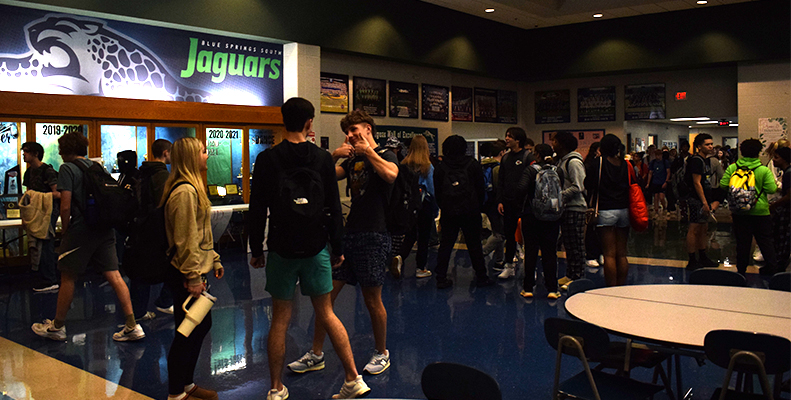Students reflect on South’s crowded hallways
Students gathering in the commons during passing period between 2nd and 3rd hour. Some students have expressed concerns over getting through hallways during passing period. Photo by Alex Miranda
April 6, 2023
By Olivia Svoboda
Editor-in-Chief
Pushing, shoving, standstills – these are some of the things a student can expect to experience in a crowded hallway.
Blue Springs South has its fair share of crowded hallways due to the school’s structure and the student population, according to principal Ryan Gettings.
“Those are probably the two big factors. We’ve grown; we added freshmen, first of all, and of course, we added on to the building, but we added 600 freshmen. That’s quite a few students,” Gettings said.
South was originally a middle school, so its first hallways were not built to fit 2,147 students.
“I mean, you can tell the difference. Obviously, you walk into the new wing, and you look at that hallway space compared to [the northside]. That’s a challenge for us,” Gettings said.
In a survey of 116 students, about 90% said they thought South’s hallways were crowded.
Students such as senior Austin Scollin are well-acquainted with South’s crowded hallways.
“I end up bumping into [about] nine people. People are in my way. People just stop – that’s really annoying – they just stop in the hallway and turn around,” Scollin said.
Scollin thinks the English hallway and the commons are the worst parts of the building to get through. Despite these issues, though, Scollin doesn’t mind, as he enjoys the busyness.
Crowded hallways can affect some students’ enjoyment of school. Gettings thinks it’s important to focus on kindness and education before worrying about crowded hallways, though.
“It’s hard to come to school and you’re walking in hallways, and you’ve got hardly any room to maneuver, or you get caught up between a crowd or something like that. That can be frustrating at times. But the other side of that is also students and staff understanding that while there are a lot of advantages of being in a big high school that other schools that are smaller may not have, there’s also things that are challenging that we have to be able to navigate around and work through, and having a lot of students is one of those things,” Gettings said.
Gettings suggests that there are schedule changes that could be implemented to clear out the hallways, if necessary, such as alternative passing times, where the student body is split up into schedules with different passing periods. He doesn’t think South is at that point, though.
The issue of crowded hallways is caused by peer behavior, according to junior Olisa Oligbo.
“It’s just really crowded; people talk with their friends and stop in the middle of the hallway,” Oligbo said.
He thinks the commons are where the issue is the most prevalent. Oligbo wants to see teachers enforcing constant movement in the hallways.
Completely preventing students from conversing in hallways is an option, but Gettings doesn’t think that would be fair.
“What I have to do is figure out how to strike the balance of helping to make this place feel like this is somewhere you want to come. Where we do have rules, we do have processes in place and things like that, but [we] also give you guys a chance as students to have the freedom to be students, to be high school students, to socialize with your friends, and do those things,” Gettings said.
There are also students who haven’t noticed any crowding in the hallways, such as sophomore Johnny Cress.
“[It’s] boring I would say, [I] just want to get to class,” Cress said.
He thinks the commons are the only part of the building with an issue, but it doesn’t need to be changed. Cress just wants there to be fewer fights.
No matter what the hallways are like, Gettings wants to make sure students are still able to connect.
“We have a lot of students that just want to walk to the next class, which is great. But if you have a group of friends that, let’s say, in between third and fourth hour you always meet at the vending machine just to say, ‘Hey, what’s going on?’ – checking in with each other. I want to protect that as much as I can,” Gettings said.

